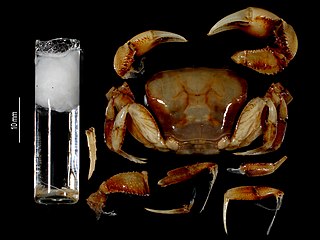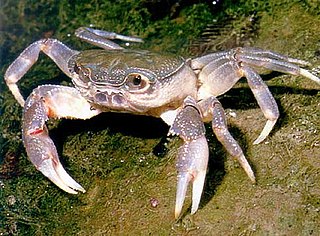
Afrithelphusa is a genus of freshwater crabs in the family Deckeniidae. It contains four species, all of which were formerly listed as critically endangered by the International Union for Conservation of Nature (IUCN). They are all endemic to the Upper Guinean forests of Guinea and Sierra Leone.
Carinurella paradoxa is a species of crustacean in family Niphargidae, and the only species in the genus Carinurella. It is found in phreatic waters of the Vipava and Soča rivers in Italy and Slovenia.
Clinothelphusa kakoota is a species of crab in the family Gecarcinucidae, which is endemic to Sri Lanka. Its natural habitats are subtropical or tropical moist lowland forests, subtropical or tropical swamps, and rivers. It is threatened by habitat loss, and is listed as a critically endangered species on the IUCN Red List. It is known from a single site with an area of less than 100 km2 (39 sq mi). Its nearest relatives are another Sri Lankan endemic genus of crabs, Ceylonthelphusa.
Niphargobates is a genus of amphipod crustaceans containing two species from European caves. Niphargobates lefkodemonaki is only known to occur in a cave near Xyloskalo in the Lefka Ori mountains, Crete, Greece. Niphargobates orophobata is only known to occur in caves near Postojna, Slovenia. Both species are listed as vulnerable on the IUCN Red List.

Oziotelphusa is a genus of freshwater crabs in the family Gecarcinucidae. Its members are found in Sri Lanka and southern India. The genus was formerly placed within family Parathelphusidae, but now it is accepted that Parathelphusidae is the junior synonym of Gecarcinucidae.
Perbrinckia is a genus of freshwater crabs of the family Gecarcinucidae that is endemic to Sri Lanka, named after Per Brinck. Its natural habitats are subtropical or tropical moist lowland forests, subtropical or tropical swamps, and rivers. It contains 14 species, most of which are included on the IUCN Red List as critically endangered species (CR) or vulnerable species (VU) because they are threatened by habitat loss; only one species is of least concern (LC).
Spiralothelphusa is a genus of freshwater crabs in the family Gecarcinucidae. It contains these species, all of which are included on the IUCN Red List:

Potamidae is a family of freshwater crabs. It includes more than 650 species and nearly 100 genera, which are placed into two subfamilies: Potaminae and Potamiscinae.

Epigrapsus is genus of terrestrial crabs. The two species are omnivores.
Johora singaporensis, the Singapore stream crab or Singapore freshwater crab, is a critically endangered species of freshwater crab endemic to Singapore. It grows to a size of 30 millimetres (1.2 in) wide.
Disparithelphusa pecki is a species of freshwater crab in the family Pseudothelphusidae, and the only species in the genus Disparithelphusa.
Brasiliothelphusa tapajoensis is a species of freshwater crabs in the family Pseudothelphusidae, and the only species in the genus Brasiliothelphusa. It was described in 1986 from specimens caught in the Rio Tapajós in the state of Pará, Brazil. It is listed as Data Deficient on the IUCN Red List.
Neoepilobocera gertraudae is a species of cave-dwelling crab from Cuba.
Achlidon agrestis is a species of crab in the family Pseudothelphusidae, and the only species in the genus Achlidon. It lives in rivers in Mexico and Costa Rica.
Eidocamptophallus chacei is a species of crab in the family Pseudothelphusidae, and the only species in the genus Eidocamptophallus.

Karstarma is a genus of karst-dwelling crabs formerly included in Sesarmoides.

Around 1,300 species of freshwater crabs are distributed throughout the tropics and subtropics, divided among eight families. They show direct development and maternal care of a small number of offspring, in contrast to marine crabs, which release thousands of planktonic larvae. This limits the dispersal abilities of freshwater crabs, so they tend to be endemic to small areas. As a result, a large proportion are threatened with extinction.

Cancrocaeca xenomorpha is a species of troglobitic (cave-dwelling) freshwater crab from Sulawesi, the only species in the monotypic genus Cancrocaeca. It has been described as the world's "most highly cave-adapted species of crab".
Migmathelphusa olivacea is a species of freshwater crab found in Lake Poso on the Indonesian island of Sulawesi. It is the only species in its genus. It is listed by the IUCN as Endangered, given "its extent of occurrence and area of occupancy is less than 500 square kilometres (190 sq mi)", and its individuals being found in less than five locations. There is also a "decline in the extent and quality of its habitat and it is not found in a protected area". Being found around a lake, "present and future threats to this species include human-induced habitat loss/degradation due to population increases and industrial and agrarian development".

Nanhaipotamon is a genus of freshwater crabs, in the subfamily Potamiscinae, found in southern China and Taiwan. As of 2018, 18 species have been described. The genus is named after the South China Sea, for it occurs mostly in coastal areas. The genus was first described by R. Bott in 1968 as Isolapotamon (Nanhaipotamon), i.e., a subgenus of Isolapotamon.









